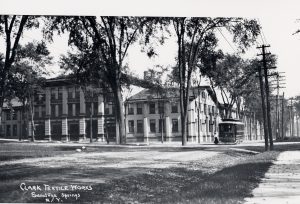
Original Clark Textile Mill
Of the many success stories Saratoga Springs can take pride in, the adaptive reuse of the Van Raalte Knitting Mill on High Rock Avenue to a professional office building is one of the most remarkable. Thirteen years after the mill closed in 1986, most people thought the 120,000 square-foot structure was beyond hope of saving. Abandoned and partly flooded, the building was starting to collapse and declared a hazardous waste site. But Tom Roohan, owner of Roohan Realty, and his father John had a special connection to the building and had a desire to see the building saved.
Of all things, it was the manufacturing of silk gloves that prompted the construction of the large building on High Rock Avenue in 1906. Silk gloves reached their greatest popularity in the last two decades of the 19th century and Joseph H. Clark, a well-known and successful silk manufacturer who had a mill in Sidney, New York, decided he needed another plant to meet demand. Senator Edgar T. Brackett persuaded Clark to take advantage of the ample labor available in Saratoga with a population of 14,000. In 1905, Clark purchased the Empire Spring for the site of his largest mill. The proximity to the spring made it a difficult site on which to build. It required Clark to use stones and rails from the former Mount McGregor Railroad as fill for the site. He built the attractive red and white brick building directly over the spring and retained the lion sculptures that once graced the entry of Empire Spring entrance to adorn the entrance of his building. The mill was one of the only factories in the world to have a mineral spring which was also accessible to all the employees.
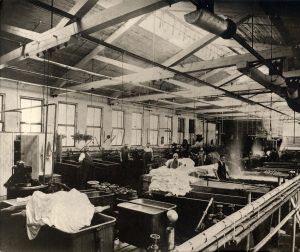
Dye Room, 1910s
From the moment the mill opened it employed 450 workers. Using silk imported from Japan, the Clark Textile Mill operations included: throwing, winding, warping, knitting, dyeing, dressing, cutting, sewing, steaming, boxing, and finishing. In 1914, the Dry Good Reporter wrote that Clark took great interest in the welfare of his workers. The article noted that in the construction of the plant every provision for comfort and well-being of his employees was made and the company had a hospital fund to care for those who contracted any illness.
In 1919, brothers Emanuel and Zealie Van Raalte, owners of a domestic veil factory in Patterson, NJ, purchased the mill upon Clark’s retirement for $1.8 million. They saw an opportunity to expand their business into silk gloves and lingerie products. The mill closed for four years due to the decreased demand in silk and the Great Depression. When the Van Raaltes reopened the mill they produced women’s mesh hosiery. As nylon, DuPont’s newly invented miracle fabric, became more widely used, the mill was retrofitted to manufacture hosiery and undergarments. Ultimately, the Van Raaltes went on to operate fourteen mills throughout the country and at its height, their Saratoga mill employed nearly 800 people and shipped 1.25 million garments a year to 10,000 retail outlets across the country. Their company slogan was “VAN RAALTE: Because You Love Nice Things.”
By the 1950s, the only Van Raalte mill in operation was the one in Saratoga. In 1968, it was acquired by Cluett Peabody & Company, the Troy-based Arrow shirt manufacturer and gave the “Collar City” its name. As sales declined in the 1970s, the corporate directors began to look for a buyer. When it became apparent the mill was in danger of closing, 41 employees and a few investors purchased the mill and renamed it the Saratoga Knitting Mill. In 1984, the mill was purchased by Falk Fiber and Fabrics of Greensboro, North Carolina, but they operated it for only two years before closing it for good in 1986 and shipping the equipment to their other facilities.
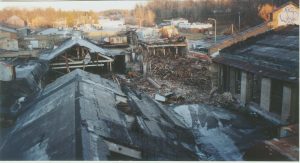
Mill in disrepair, 1999
Since that time the building sat vacant and languished. By 1995, the mill was considered a danger by City officials. It was feared that the 80 foot smokestack would collapse, the site was overgrown and littered with debris, vagrants were entering the property, and water flooded the building. According to Tom Roohan, he and his father John always had a “soft spot” for the mill because it once was one of the largest employers in Saratoga, and also because their neighbor and friend Frank Riley was the last manager of the facility. John felt it was an embarrassment to downtown Saratoga Springs. Tom and John sat down with Sonny Bonacio to discuss how the building could be saved. Shortly after John passed away in February 1998, Tom and Sonny again discussed the project and together they decided, in blind trust and faith, to take on the building.
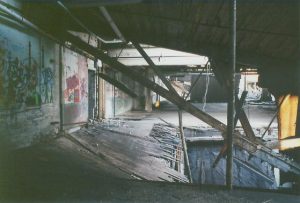
Mill interior, 1999
Meanwhile the City, after waiting nearly a decade for a developer to purchase the building and renovate it, was moving forward with the court process to force the owners, Falk Fiber and Fabrics Common Shareholders Trust, to demolish the structure in April. During the New York State Supreme Court hearing in July, Sonny and Tom stepped in and declared their intention to purchase the building despite the condition of the building, trees were growing out of the roof and areas were collapsing, in addition to PCB contamination. When asked “Why did you take on this building?” Sonny’s immediate response is “Stupidity.” However, his true answer is “It was a great building with interesting architecture inside and out that had a lot of potential.”
In 1999, they purchased the building for $400,000. Their plan called for saving the oldest and most architecturally significant southwest end of the structure as well as the 1960-era warehouse at the northeast end of the site. They would remove the crumbling middle section which was the most contaminated and use the space for parking. Tom says the project would not have been possible without the Adirondack Trust Company who financed the building when they had no tenants or without participating in the Voluntary Cleanup Program with the NYS Department of Environmental Conservation. In the end Sonny and Tom invested over $8 million dollars. The building was completed in 2001, but it did not end there. In 2004, the spring was returned to the site, and most recently they removed the unattractive loading dock. As Tom says “It continues to be a work in progress.”
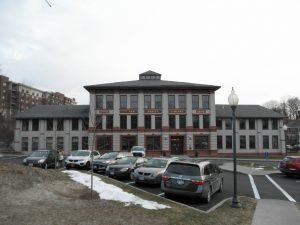
Van Raalte Mill, 2013
Sonny and Tom are proud to give the mill a new life. They should be. For without their hard work and determination, an important piece of Saratoga Springs’ history may have been forgotten, but today the building remains a reminder of a business that once provided employment to nearly 800 people in our community.
Founded in 1977, the Saratoga Springs Preservation Foundation is a private, not-for-profit organization that promotes preservation and enhancement of the architectural, cultural and landscaped heritage of Saratoga Springs.
